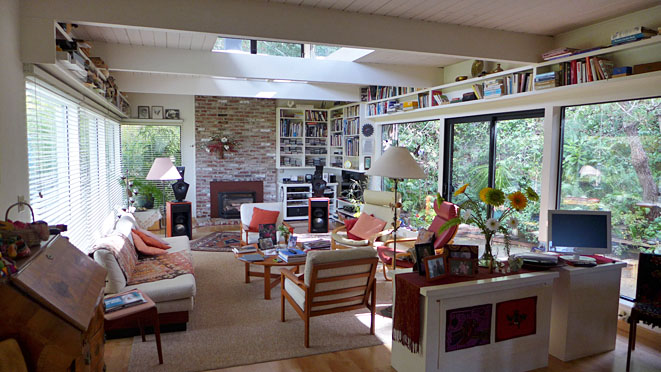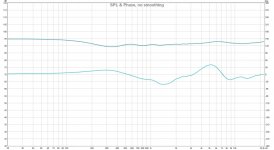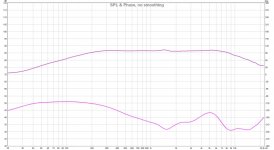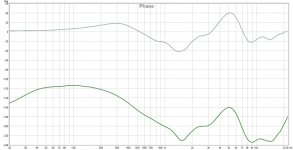I don't know what you mean by this: "Off axis /On axis does not really matter for me, direct/reverberated is what i try to control." Those are intrinsically related! Actually I may know what you mean. The direct sound could be the off-axis sound, if you are toeing in.
First i insist that all this stuff is strictly about imaging...

The question is that the speakers you quote have been designed on axis and intended to be listened to on axis and this is simply what imho is wrong with them.
The ratio Direct/Reverberated is the On Axis/ Power Response and as can be seen on the M2 curves, when the speaker is designed and listened on axis, the divergence is too big making short sounds tonally too bright and long sounds tonally too dull, and imaging flawed.

This is why i find a small full ranger like a Jordan JX92 images for me way better that the quoted examples.
Of course you can use DSP to tweak any loudspeaker response and might call this digital room correction, but honnestly you do not do any thing to the room, but simply change the room response of the speaker so that you cannot pretend that you have designed the speaker for any room...
To make a long story short, what i try is to mimic a JX92 with any multiway speaker using dsp, but first i toe in, because obviously it makes no sense to toe in a speaker that measures flat on axis. For the toe in affair to work the response has to be rising whwn measured on axis.
As for rooms, this is for me what a room for serious listenning looks like.
I really love those big panels of ... acoustic glass ? 😀

Btw, and keeping on topic, an old paper from Ted Jordan about stereo:
http://www.ejjordan.co.uk/PDFs/Jordan_WW_Feb_71.pdf
Last edited:
A beer on its something close to some kind of +/- 20º Pano Rephase shuffler 🙂
Haha. Well, its a 2-in, 3-out matrix so probably not!
The question is that the speakers you quote have been designed on axis and intended to be listened to on axis and this is simply what imho is wrong with them.
The ratio Direct/Reverberated is the On Axis/ Power Response and as can be seen on the M2 curves, when the speaker is designed and listened on axis, the divergence is too big making short sounds tonally too bright and long sounds tonally too dull, and imaging flawed.
...
To make a long story short, what i try is to mimic a JX92 with any multiway speaker using dsp, but first i toe in, because obviously it makes no sense to toe in a speaker that measures flat on axis. For the toe in affair to work the response has to be rising whwn measured on axis.
To me it seems to be just an issue of voicing then. You can EQ any speaker brighter to compensate for toe-in, if you still want a flat response on the listening axis. Geddes speakers for instance are not designed to be listening on-axis anyway. Linkwitz neither, but you knew that! 😉
With correct toe-in of a CD speaker you can match the timbre of the direct and reflected sound... Just toe in so you are listening 30 degrees off the speaker axis. Your first sidewall reflections will also be roughly 30 degrees off the speaker axis. Same exact timbre. The power response will also closely match this sound, bright spot being aimed away from first-reflection points.
Not sure how to get a flat power response AND listening axis response from low to high frequencies in any monopole speaker though, rising treble response or not. Sorry if I'm being daft.. would like to know. And, is a flat power response desirable? Is this even what you are advocating?
I see that the paper you posted is very much along the lines of this thread so I will try to read it (its very fuzzy!)..
From the paper:
How did he come up with this? Why is this superior to CD starting at a lower frequency?A very suitable characteristic would be to have a difference of about 6dB at 15kHz between the response on-axis and 30 degrees off-axis
This problem would be minimized by having CD down to a lower frequency, it is a result of the "suitable characteristic" described above.An additional problem arises in the crossed polar system when broad images occur: there is apparent sound movement within the image which is frequency conscious
This doesn't jive with your preference for an omnidirectional source. Sure, there is a sweet spot for directionality which best compensates for off-axis listening where one speaker is closer than the other. I just don't believe his characterization (first quote above) is correct. But, this paper primarily concerns off-axis listening, not reflective/direct timbre relationship.If the loudspeakers tend to be either omnidirectional or on the other hand extremely directional, then the image distortion will be so bad as to render the additional cost of stereo over mono quite unjustifiable
Well this is a much simpler 3 channel matrix than any of us have put forth...The middle speaker was fed with a sum signal from each channel attenuated by 20dB...
Yes, but the image would be substantially narrowed, and frequency dependent narrowing at that. This is the opposite of what Gerzon suggests for a frequency balanced width reproduction (which would have the low frequencies getting wider, to compensate for errors in both stereo microphone techniques, and real-world speaker reproduction).The centre unit faced upwards and was fed from both channels at full level. This resulted in an effective gentle top roll-off above around 3kHz ... an almost perfect central image was secured
I find it very hard to believe that this would not be apparent. Perhaps when listening to vinyl records with a summed bass channel, as I'm sure was the case when this article was written.{in relation to a central pair of speakers facing outwards into reflectors) In spite of the fact that all very low frequencies will be coming from the centre, this is not apparent when listening. The reflectors in any case will start to become operative only above about 200Hz.
The full delay-line system he describes reminds me of modern sound bars in operation. These pique my interest more than the aforementioned techniques, but the details are a little bit sparse.
The version I'm building right now will include an actual center speaker, but I thought much of the same circuitry could be used for clarifying a phantom center image with just two spkrs as well.
Please share your development and results! I am very interested.
With correct toe-in of a CD speaker you can match the timbre of the direct and reflected sound... Just toe in so you are listening 30 degrees off the speaker axis. Your first sidewall reflections will also be roughly 30 degrees off the speaker axis. Same exact timbre. The power response will also closely match this sound, bright spot being aimed away from first-reflection points.
Yes 30º works fine for me.
Don't need flat power response though. The targets that work fine for me are classical B&Ks or Tacts, with this slow decaying slope that is curiously similar to Ted' s 30º curves...Where/how did the guys at BK found their inspiration?🙄
Regarding CD starting at lower frequency, i cannot comment and have really nor idea nor experience. Anyway the problem of dull center i think is basically a >1khz issue, or i missed something. Btw, I dont like the imaging of small monitors that imho are only ok nearfield. The Jordan's driver for example really shines on the 30cm baffle of the VTL, and wider baffles surely allow kindof CD at a lower frequency than the 2khz of the raw driver. So there is probably something worth digging there...
The -6db/30º affair is what especially interested me most in Ted Jordan' s paper, which i also find a bit weird and fuzzy, but well, as we all know these guys are somewhat excentric, drive on left, etc...

Last edited:
I did, years ago. It's a very simple matrix :As for the SST processor, it would be pretty cool to do some measurements on one and find out what's going on! 🙂
L' = L - 0.5*R
R' = R - 0.5*L
C = 0.5*(L+R)
(btw, if you have true balanced preamp outputs the matrix can be made passively with a few resistors).
More generally :
L' = L - k*R
R' = R - k*L
C = (1-k)*(L+R)
k = adjustable, 0.3 ... 0.7 is a good range to start with.
When k=0 it's normal stereo, when k=1 it's M-S but with a missing center (not usable)
This what inside the 'processor' offered by MilesTech company.
Works quite well, but Michael Gerzon invented an even better variant (long before J.Bongiorno and M.Miles, it seems) where k is made frequency dependant, this yields a most natural and balanced sounds of all phantom images.
It's called 'Tri-Field' (US Pat # 5671287).
With linear phase (FIR)-Filters it's a charm, with analog filters you get an additional allpass behaviour (not ideal if you're not 'phase-deaf' and have linear phase loudspeakers).
For me, the striking difference compared to 2-speaker stereo is the stability of the soundstage vs head movement and rotation.
The downside is that recordings that have '3D'-content based on 'Q-Sound' etc (crosstalk cancelling) don't work well...
Last edited:
The proper way to do a center would be to extract from the left and right channels that part of the two signals that were correlated. This can be done with DSP. The correlated signal is then the center channel and the left and right channels do not contain any of the signal in the center channel. I was told that this is precisely what Dolby does, but I can't confirm that.
To me it seems to be just an issue of voicing then.
I missed that...
You seem to consider voicing a mere tonal balance issue. I totally disagree, imaging cannot be good if tonal balance is not ok, and tonal balance will be wrong if imaging is not good. These are not different matters, just both sides of the same coin, and btw, surely not a matter of personnal taste.
Though taste is also another can of cultural worms...
I missed that...
You seem to consider voicing a mere tonal balance issue. I totally disagree, imaging cannot be good if tonal balance is not ok, and tonal balance will be wrong if imaging is not good. These are not different matters, just both sides of the same coin, and btw, surely not a matter of personnal taste.
Though taste is also another can of cultural worms...
( flat on axis, downslope off-axis ) + rising EQ = ( rising on axis, flat off-axis )
Of course the power response will change following the EQ change, which might not be ideal.
The proper way to do a center would be to extract from the left and right channels that part of the two signals that were correlated. This can be done with DSP. The correlated signal is then the center channel and the left and right channels do not contain any of the signal in the center channel. I was told that this is precisely what Dolby does, but I can't confirm that.
Sounds right in setups with real center speaker but here for stereo speaker setup we only have left or right speaker to route any DSP extracted signal.
BYRTT - understood, there was some discussion here of using a real center. I have a real center in my system so I think in those terms.
gedlee,
Sometimes miss simple mono recording and mono speaker to save time spent on setup, but no doubt will probably have to adopt center and more modern setups down the road 🙂.
Sometimes miss simple mono recording and mono speaker to save time spent on setup, but no doubt will probably have to adopt center and more modern setups down the road 🙂.
Pretty much, yes, depending on the processor. The original Dolby cinema processor did not remove any (or much) center from th sides, IIRC. It's been a long time since I looked at the schematic. This was the common approach in cinemas across the world.This can be done with DSP. The correlated signal is then the center channel and the left and right channels do not contain any of the signal in the center channel. I was told that this is precisely what Dolby does, but I can't confirm that.
Some of the home processors, like Pro Logic, had more steering for smaller setups such as home theater.
I always thought the original Dolby encoding was very clever. Out of the same optical soundtrack on the film you could easily get mono, stereo, LCR and sound. All compatible with different sound heads and processing or no processing.
I even ran a old cinema in S.F. where we had mono center with surround. 😀
Of course the power response will change following the EQ change, which might not be ideal.
Yes it is not ideal when a loudspeaker measuring flat on axis but with an exagerated fall in power response (like M2...
 ) is applied DRC.
) is applied DRC.What happens then is that even when Eq is apllied with a decaying target like B&K the direct sound will become way too bright ( logical, if it was flat out of the box, it will now be rising...), and this should invite to toe in the speaker and try eq again, till imaging becomes acceptable, removing its builtin over brightness to the direct sound ( the JBL/Infinity touch...😀) and its dullness to reverberated sound ( especially in the center).
Last edited:
Let's try and bring this back on subject a bit. I stumbled over a couple of older files from Professor Edgar Choueiri, known for his BACCH 3D sound implementation.
These are older files, when he was still on the Ambiophonic route.
What was interesting in these files is the phase swings:

Direct sound IR

Cross talk IR (this one is inverted)
I haven't figured out why these phase swings are used in this case yet. As the right IR's look exactly the same as the left, but he swapped both IR pulses.
Here's the phase of both in one plot:

Professor Choueiri abandoned the Ambiophonic route shortly after and continued to pursue a more complicated algorithm but the targets he had in his early work are quite identical to "our shuffler".
A link to his later work is here: https://www.princeton.edu/3D3A/Publications/BACCHPaperV4d.pdf
These are older files, when he was still on the Ambiophonic route.
What was interesting in these files is the phase swings:
Direct sound IR
Cross talk IR (this one is inverted)
I haven't figured out why these phase swings are used in this case yet. As the right IR's look exactly the same as the left, but he swapped both IR pulses.
Here's the phase of both in one plot:
Professor Choueiri abandoned the Ambiophonic route shortly after and continued to pursue a more complicated algorithm but the targets he had in his early work are quite identical to "our shuffler".
A link to his later work is here: https://www.princeton.edu/3D3A/Publications/BACCHPaperV4d.pdf
Attachments
Last edited:
If the topic is cross talk cancelation and hairy nerd stuff like shuffling , center speaker, or ambio which only half work depending on how recordings are made, ok, don't worry I...

Last edited:
Well it isn't, (except for the shuffling part) but cross talk cancelation certainly has similarities. But we weren't talking about speaker design specifically. Only the tonal differences between center and sides. Cross talk cancelation is related I think, but entirely different in it's principles. We are trying to solve a similar puzzle.
The perceived phantom center combing is actually created (at least in part) by the cross talk of left speaker reaching the right and vice versa.
If your OB speaker doesn't suffer from that, that's perfectly OK, and probably has to do with early reflections being different in such a setup.
But a question for you, what do you think about Mr. Linkwitz's Watson project? http://www.linkwitzlab.com/Watson/watson.htm
Or his surround experiments for 2 channel recordings? http://www.linkwitzlab.com/surround_system.htm
It makes me think 2 channel OB also does not have all of the answers to solve the Stereo reproduction. Else these experiments would have been redundant.
The Linkwitz room you posted a picture of is filled with extra's to aid in the Stereo perception. Just a different route.
The perceived phantom center combing is actually created (at least in part) by the cross talk of left speaker reaching the right and vice versa.
If your OB speaker doesn't suffer from that, that's perfectly OK, and probably has to do with early reflections being different in such a setup.
But a question for you, what do you think about Mr. Linkwitz's Watson project? http://www.linkwitzlab.com/Watson/watson.htm
Or his surround experiments for 2 channel recordings? http://www.linkwitzlab.com/surround_system.htm
It makes me think 2 channel OB also does not have all of the answers to solve the Stereo reproduction. Else these experiments would have been redundant.
The Linkwitz room you posted a picture of is filled with extra's to aid in the Stereo perception. Just a different route.
Last edited:
But a question for you, what do you think about Mr. Linkwitz's Watson project?
Interesting as a laboratory experiment, but 2 complicated: Stereo is about 2 speakers reproduction, tha't how musical programs are made and intended to be reproduced, flawed as it is, that's it ... Overenginerring things ( the Dolby way...) always bad😎
Much more interesting if find its LX mini.
Last edited:
What was most flawed in my home certainly was my listening room. Introducing something extra after first taking a few things away did go a long way of solving that bad room problem for me.
Even if it took introducing 2 extra channels. Not Dolby, not Logic 7, just my own recipe. Mostly based on the old and abandoned Haas Kicker concept. Not that great for a studio, but a lovely concept for a listening room.
But even that has little to do with the discussion at hand. To each his own I say. What I do with the extra channels is quite comparable to what Linkwitz did with his surround channels.
The point of me bringing this up is because especially that Watson experiment has a lot in common with the subject of this thread. Even the LX mini can't solve that.
Even if it took introducing 2 extra channels. Not Dolby, not Logic 7, just my own recipe. Mostly based on the old and abandoned Haas Kicker concept. Not that great for a studio, but a lovely concept for a listening room.
But even that has little to do with the discussion at hand. To each his own I say. What I do with the extra channels is quite comparable to what Linkwitz did with his surround channels.
The point of me bringing this up is because especially that Watson experiment has a lot in common with the subject of this thread. Even the LX mini can't solve that.
- Home
- Loudspeakers
- Multi-Way
- Fixing the Stereo Phantom Center


